
Let students EXPERIENCE each form of energy with this HANDS-ON forms of energy activity!
Let me just say this upfront… this activity seems daunting at first. I get it! There’s quite a few moving pieces. But I promise you, this is one of the most rewarding hands-on activities you’ll do all year!
Check out this video on Instagram to see how fun it is!
The good thing about this activity is that you only have to do the “hard” part once. The part that requires a *bit* of work is gathering all the supplies. BUT once you have done this, you can use the same supplies year after year after year. (Just keep them in a bin together.) It’s a one-time, upfront work type of thing, and after that it’s just all fun.
And, please note that the FREE hands-on forms of energy activity student sheet and station card (FREE) that I provide are fully editable, so you can use your judgement to easily make substitutions for any of the supplies or tasks required.
I do hope you try it – every year this activity is one of my students’ most talked about experiences! More importantly they truly remember what they’ve learned.
This is a stations activity. I set up each of the 9 stations – one for each form of energy – around the room. Each station has a “station card” with specific instructions for that station and the supplies needed for that station. (I laminated the stations cards so they can be reused.)
Groups or pairs of students spend about 5 minutes at each station. As they complete the tasks on each station card, they answer some brief questions on a student sheet.
Below, I’ll describe the tasks that students will perform for each form of energy. The only station that isn’t hands-on is the nuclear energy station (for obvious reasons).
Remember, you can get both the station cards and the student sheet HERE!
Needed for this station: calcium chloride, water, 2 teaspoon measures, sandwich bags
Task One: Calcium chloride has chemical energy stored in the bonds between its atoms. When it reacts with water, the chemical energy in these bonds can be released. Add a half of a teaspoon of calcium chloride to a sandwich bag. Then, add a half of a teaspoon of water to the bag. Quickly seal the bag and feel the mixture.
Task Two: Food has chemical energy stored in its bonds. When our body digests food, it releases this stored energy so that we can use it for movement and body heat. Record what you ate at your last meal. Do 20 jumping jacks. Do 4 push-ups. Run in place for 1 minute. The energy for these activities comes from the stored chemical energy in food!
Needed for this station: Nuclear Energy Reading (included with free download of student sheet)
Task: Complete the reading about nuclear energy provided at this station and answer questions.

Needed for this station: meter stick, tennis ball
Task 1: Use a meter stick to measure 100 centimeters from the ground. Hold the tennis ball slightly away from this mark. The muscles in your arm used energy to pull it against gravity, so the ball now has gravitational potential energy. Now, drop the ball and let it bounce a few times. Measure how high (in cm) the ball bounces back up on the first bounce. Record your data on the answer sheet. Also, pay attention to how high the ball bounces back after each consecutive bounce.
Task 2: Repeat the same procedure, but this time drop the tennis ball from about 50 centimeters from the ground.
Task 3: Make a prediction as to how high the tennis ball will bounce if you drop it from the highest point that you can. Write your hypothesis on the answer sheet. Measure how high this point is, and then drop the ball. Record how high (in cm) the ball bounces back on the first bounce. Pay attention to how high the ball bounces back after each consecutive bounce.
Needed for this station: ammeter, wires with alligator clips, light bulb, light bulb holder, D batteries, battery housings
Task One: Assemble the circuit as shown in the picture below. First, put one battery in the circuit. Observe how bright the light bulb is.
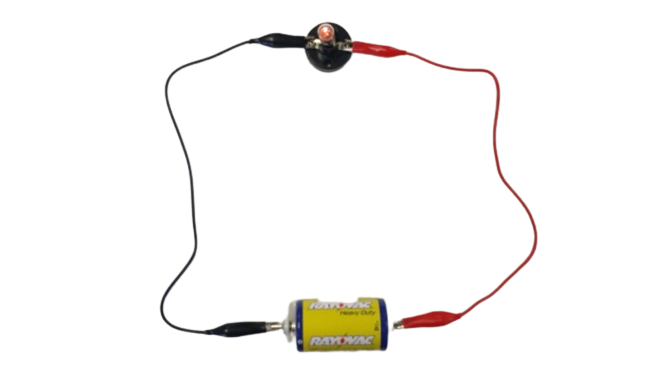
Task 2: Make the circuit with two batteries. Does this change the brightness of the light bulb? Then, complete the circuit with three light bulbs. Did the additional battery affect the brightness?
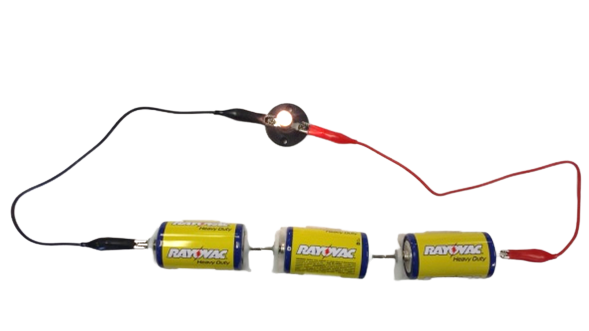
Task 3: Assemble the circuit as shown in the picture. This time, attach the ammeter (a device that measures electric current). Does the reading on the ammeter change? If not, re-arrange the parts of the circuit until you make the needle on the ammeter change. What does the moving needle indicate?
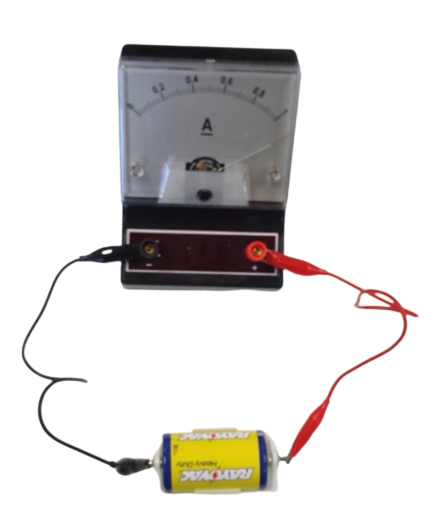
Needed for this station: assortment of small balls of different masses, scale, rulers with grooves (2), wooden block
In this activity, students will see how changing the amount of mass affects the amount of mechanical energy an object has.
Task: Use the scale to record the mass of each of the small balls provided. Record their masses on your paper. Use a ruler to make a ramp. Lift the end of the ramp to 10 centimeters high. (Use the other ruler to measure this.) Now, place the wooden block at the end of the ramp. Lift one of the balls to the top of the ramp and let it go. Measure how far the wooden block was pushed. (You may need to do this a few times to make it roll correctly.) Repeat this procedure for each one of the small balls. For each ball, record how far it was able to push the block.
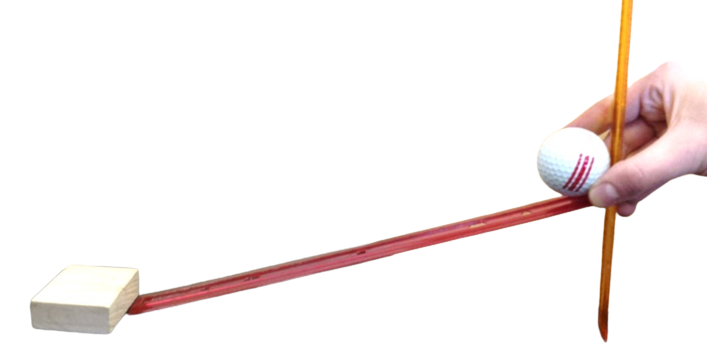
Needed for this station: tuning forks, PVC tube, container of water, graduated cylinder (that fits the tube) with water, ping pong ball with attached string (tape works), plastic food container, dry rice
Task 1: Carefully and VERY GENTLY strike the tuning fork to your desk. Bring it towards/away from your ear. Touch the tuning forks when it is making sound. Now, repeat with the other tuning fork. Then, try different ways of gently hitting the tuning fork (with your pencil, against different materials, etc.) to see if you can change the sound in any way.
Task 2: Gently strike the tuning fork and then lower it into the container of water. Observe what happens to the water. Now, place the tube in the water. Gently strike the tuning fork. Hold it above the tube. Put your ear to the tube and listen.
Task 3: Hold up the ping pong ball by the string. Touch your finger to the ping pong ball as it hangs. Nothing happens, right? Now, gently strike the tuning fork and touch it to the ball. Observe what happens to the ball.
Task 4: Open the food container and take out JUST A PINCH of rice. Replace the lid and then place the rice on the lid of the plastic food container. Touch your finger to the lid. Nothing happens, right? Now, gently strike the tuning fork and touch it to the lid. Observe what happens to the rice.
Needed for this station: candle spinner, matches, candle, 2 thermometers, large container cold water, large container of hot water, balloon, plastic bottle
Task 1: Observe the spinner. Is it moving? Carefully use a match to light the candle inside the spinner. After the candle has been lit for 1 minute, carefully put your hand above the spinner. Can you feel the heat without touching the fire? Now, observe the spinner blades. After you have observed the spinner blades, GENTLY blow out the candle.
Task 2: Use a thermometer to measure a) the temperature in the room, b) the temperature of the hot water, and c) the temperature of the cold water. Record the temperatures. Then, stretch the balloon over the mouth of the bottle. It should be floppy. Place the bottle in the container of hot water and leave it for a while. Observe what happens to the balloon. Now, place the bottle in cold water. Observe what happens to the balloon.
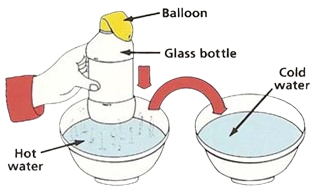
Needed for this station: Slinky, meter stick, rubber bands, rubber band butterfly, rubber band car, book
Task 1: Stretch the Slinky so that the edges are 25 centimeters apart. Then, let it go. Observe what happens. Repeat this procedure at 50cm, 75cm, and 100cm.
Task 2: The diagram shows where to gently grab the butterfly with one hand on the head and one hand on the tail. Turn the butterfly so that the elastic twists 4-5 times. Carefully place the butterfly in a book. Leave the book for a bit, and then open it. Observe what happens!
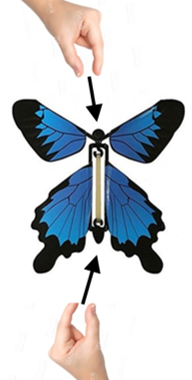
Task 3: Hold the car by the rear (back) wheels and flip it over 5 times. You should see the elastic on the bottom of the car twisting. Put the car on the floor where it will have room to go a distance without hitting anything. Let it go and observe what happens.
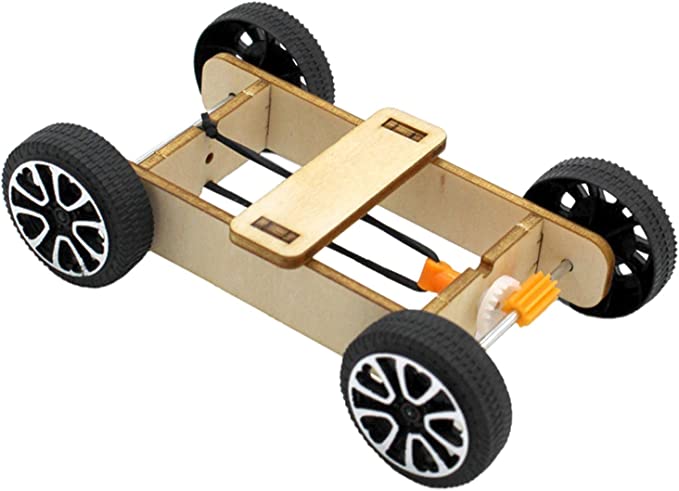
Needed for this station: “dancing” solar animal, diffraction glasses, diffraction slides
Task 1: The “dancing” animal has a solar panel. Leave the animal on the desk and put your thumb over the solar panel for a while. Observe. Take your thumb off again and observe what happens.
Task 2: Energy that travels in waves is radiant energy. There are many types of radiant energy. Longer wavelengths are radio waves and used in microwaves. Very short waves are used in x-rays. Light is also made of waves. Within visible light, different wavelengths produce different colored light. However, visible light contains all the colors, so we usually only see “white” light. We can use diffraction glasses to separate the wavelengths so we can see each of the colors in light individually.
Put on the diffraction glasses and look around the room. Then, use the small square diffraction slides to look around the room. Use the scale to try to figure out exactly what wavelengths you are seeing.
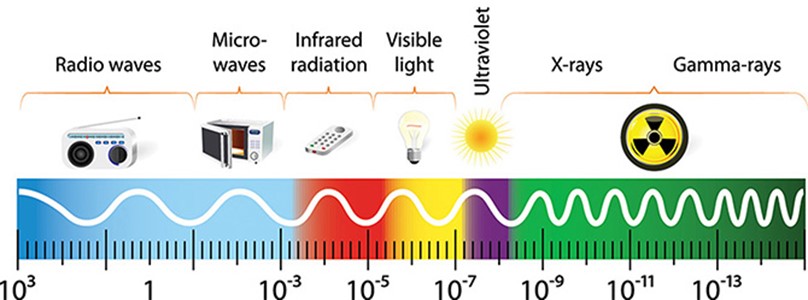
Don’t forget to grab your FREE student sheet and station cards! If you try this hands-on forms of energy activity, I would LOVE to hear back how it went!
As an Amazon Associate I earn from qualifying purchases.
© Flying Colors Science 2025 | Terms & Conditions | Privacy Policy | Disclaimer
| Cookie | Duration | Description |
|---|---|---|
| cookielawinfo-checkbox-analytics | 11 months | This cookie is set by GDPR Cookie Consent plugin. The cookie is used to store the user consent for the cookies in the category "Analytics". |
| cookielawinfo-checkbox-functional | 11 months | The cookie is set by GDPR cookie consent to record the user consent for the cookies in the category "Functional". |
| cookielawinfo-checkbox-necessary | 11 months | This cookie is set by GDPR Cookie Consent plugin. The cookies is used to store the user consent for the cookies in the category "Necessary". |
| cookielawinfo-checkbox-others | 11 months | This cookie is set by GDPR Cookie Consent plugin. The cookie is used to store the user consent for the cookies in the category "Other. |
| cookielawinfo-checkbox-performance | 11 months | This cookie is set by GDPR Cookie Consent plugin. The cookie is used to store the user consent for the cookies in the category "Performance". |
| viewed_cookie_policy | 11 months | The cookie is set by the GDPR Cookie Consent plugin and is used to store whether or not user has consented to the use of cookies. It does not store any personal data. |